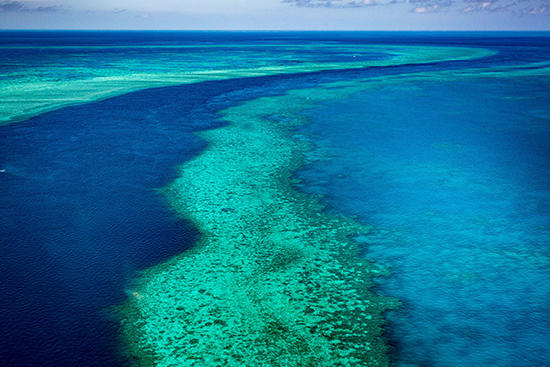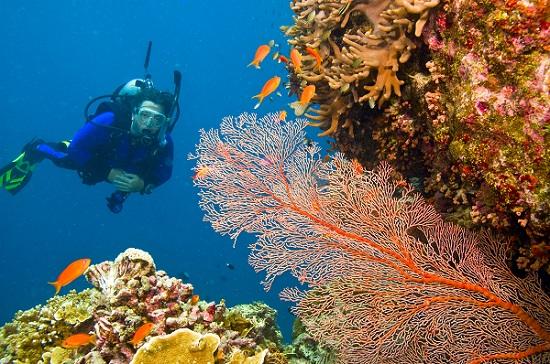9 Fun Facts about the Great Barrier Reef
Famous the world over for its colourful corals and fascinating fishes, the Great Barrier Reef sits high on the travel must-sees list. Together with Sydney and Uluru, it forms part of Australia’s trio of top sights, with many travellers combining the three for the ultimate Aussie adventure. And you don’t even have to be a diver to appreciate it – the reef can be seen in many ways, from glass-bottomed boat trips to scenic flights, meaning everyone has a chance to explore this natural wonder. Here are nine of our favourite fun facts about the Great Barrier Reef:

Finding Nemo is almost guaranteed
In real life, Nemo, the wayward clownfish from the Disney movies Finding Nemo and Finding Dory, would be pretty easy to find. The adorable little orange and white clownfish is just one of 30 clownfish species that inhabits the Great Barrier Reef, living in large numbers among the corals and anemones. The easiest way to spot Nemo for yourself is to sign up to a diving or snorkelling trip, or set sail in a glass-bottomed boat.

The reef is huge
At 344,400km2, the Great Barrier Reef is around the same size as Finland. That’s 16.5 times the size of Wales and the equivalent of 70 million football pitches. Not only that, but it’s the largest living structure on earth – so large in fact that it’s also the only living structure on earth that can be seen from space.

The reef is made up of over 900 islands
When it comes to islands, there’s a plethora of choice on the Great Barrier Reef. Not all of them are inhabited, or have much more than a patch of sand and a smattering of forest, but all of them will live up to your desert island ideals. Lady Elliot Island, the southernmost one, is known for its turtles and manta rays, while Lizard Island is home to Australia’s northernmost island resort, and rather swanky it is too. If you want to explore a few you could try island hopping the Whitsundays, where you’ll also find the legendary Whitehaven Beach.

Whitehaven Beach is award-winning
Speaking of which, Whitehaven Beach features heavily on various lists of the world’s favourite beaches. Most recently, CNN Travel voted it number 11 in its annual list of the World’s Top 100 Beaches; it also won their 2010 World’s Most Eco-Friendly Beach Award. But don’t take their word for it: ride a seaplane, join a boat trip or fly in a helicopter to explore the pure white silica (which squeaks underfoot) and swim in the pure turquoise waves.

There’s a huge diversity of life
The Great Barrier Reef is home to 10% of the world’s fish species, including snappers, wrasse and coral trout. But it’s not just about the fish: 10,000 dugongs, 30 species of whales and dolphins, and six species of sea turtle live here, as well as 215 bird species and 5,000 types of mollusc. You’ll also find 17 varieties of sea snake, 134 sharks and rays (including the fearsome great white) plus the occasional saltwater crocodile.

It’s a World Heritage site
The Great Barrier Reef was designated a UNESCO World Heritage site in 1981. In fact, it is the only place on the planet where two World Heritage sites sit side by side, together with its neighbour the Daintree Rainforest in Cape Tribulation. This gives rise to Cape Tribulation’s advertising slogan ‘Where the Rainforest Meets Reef’. Furthermore, in 1997, CNN named the Great Barrier Reef as one of the Seven Natural Wonders of the World, along with the Grand Canyon and Mount Everest.

The reef is 500,000 years old
Yes that’s right; the reef began to form over half a million years ago, when sea water temperatures had increased enough to allow coral to breed. The corals grow at a rate of 1-25cm per year, with today’s reef made up of newer corals thought to be around 6,000 years old, growing on the dead older corals. Rising sea levels around 20,000 years ago allowed the corals to grow higher, forming the cays and reefs we see today.

The reef is pretty shallow
Good news for divers: the Great Barrier Reef has an average depth of just 35 metres. Most corals and fish grow near to the surface where there’s more light, allowing snorkellers and scuba divers to explore at leisure, especially along the Inner Reef. If you head to the Outer Reef though you’ll find out what Nemo was talking about when he feared the mysterious ‘drop-off’, as here the Continental Shelf drops over 1.2 miles into the dark waters below.

You can explore the Great Barrier Reef on Google Street View
Launched in 2012, Google’s underwater Street View of the Great Barrier Reef is a great way for armchair travellers to explore the underwater wonders of the region. Created using images obtained by the Catlin Seaview Survey Project, which aimed to learn more about the world’s corals, this allows curious web users to take part in virtual dives, discovering the goings-on under the waves and spotting a few passing turtles. Take a look!
Tailor make your Queensland holiday to include the Great Barrier Reef – you can make an appointment at your local branch and chat to our Australia Experts today.




